-
Car Reviews
- All reviews
- Midsize SUVs
- Small cars
- Utes
- Small SUVs
- Large SUVs
- Large cars
- Sports SUVs
- Sports cars
- Vans
Latest reviews
- Car News
-
Car Comparisons
Latest comparisons
- Chasing Deals
Incredible straight-line performance meets its match in a brilliant suspension and steering tune with the Kia EV6 GT – a blend rarely achieved by any EV

It’s a tempting idea: electric Porsche-like acceleration at (less than) half the price of a Taycan, paired with the trustworthy durability and reliability of a Kia. Astonishingly, the latter brand’s new, $99,590 EV6 GT sports SUV promises to be just that.
Porsche’s boffins in Zuffenhausen needn’t worry too much: the sultry suppleness of a Taycan GTS remains the superlative performance-EV experience at any money, but for a brand once regarded as bargain-basement fodder, the EV6 GT is mind-blowing.
So is the underlying EV6 model, though, which is the biggest problem for the new GT grade – a flagship tier that pushes $110,000 driveaway once the wheels hit the road in Australia.
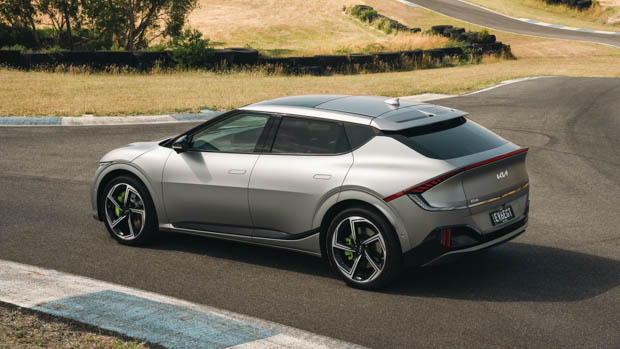
With nearly identical styling to the existing EV6 GT-Line that launched locally in February 2022, it will be trainspotters who pick the true GT version’s electric-green brake callipers and subtly retouched bumpers.
Those who test drive the car may also note the GT’s not-so-modest uptick in performance. A substantially fettled rear electric motor – and an entirely different front motor – catapults peak EV6 outputs to 430kW/740Nm – considerably more than the Stinger GT it will replace as Kia’s flagship.
A 430kW Kia would have been laughable a decade ago and is still pretty mind-boggling now. Similar figures will soon be deployed by cousin Hyundai in that brand’s Ioniq 5 N and Ioniq 6 N performance models.

Thankfully, the numbers are far from vanity figures, as the EV6 GT was not only a personal project of Hyundai-Kia’s famed R&D boss Albert Biermann, but the model has also been granted an extensive program of local ride and handling adjustment.
But the EV6 GT isn’t perfect – no car is. So, flaws and foibles taken into account, is the super-Kia really worth putting six-figures of your hard-earned down on – and likely waiting the best part of a year for one?
For many Australians, the idea of a Kia costing more than $100K-driveaway will be confronting. That’s normal – but the existence of the EV6 GT is just the latest development in Kia’s very deliberate strategy to grow its premium appeal.
Still, it’s a plus that the EV6 GT is delivered fully-loaded in Australia. In some markets there are options lists, but in Australia, extra-cost items for the GT are limited to paint colours.

However, there are notable omissions that at this price feel stingy. Chief among these is that Kia’s choice of a very tight and sporty bucket seat meant eliminating electric seat adjustment adjustment, memory and seat cooling – all items we’d expect at a six-figure level.
In Australia, standard equipment on the EV6 GT includes:
The sole no-cost paint colour for the EV6 GT is runway red. $595 buys you one of five optional paint colours: aurora black pearl, snow white pearl, yacht blue, steel grey, or glacier grey. Moonscape grey matte paint costs $3295 and includes ceramic paint protection.
We were already impressed with the driving dynamics of the existing EV6 range, with the caveat that the lack of an Australian steering tune hampered a great driver’s EV.
Well, the EV6 GT corrects the steering issue and enhances much more about the way this two-tonne electric crossover gets down a poorly-surfaced Australian country road.
Kia has a knowledgeable engineering team based in Australia that tunes most of the company’s models specifically for local road conditions. With last year’s regular EV6, those efforts were impacted by COVID-19 – but the GT model has received a full retune.

It sounds like that was pretty important: read a few reviews of the EV6 GT from the British and European motoring press and you will find complaints that the car is quick but far too stiffly-riding.
We were delighted to find that a poor ride is not a problem here in Australia. That’s because Aussie engineers extensively retuned the suspension for our tastes, with brand leaders telling Chasing Cars that the aim was to deliver rally-car compliance rather than racetrack firmness.
While both Kia and Hyundai are working with similar mechanicals to deliver their midsize electric performance flagships – this EV6 GT, and Hyundai’s forthcoming Ioniq 5 N – there is a chance the Kia will be the better-suited car locally. It is intended as a supple GT tourer, while Hyundai is concentrating on making the Ioniq 5 a truly track-ready beast.
Kia’s tuning effort took place in Nurburg, Germany, Namyang, South Korea and on the pockmarked B-roads of Victoria’s Strzelecki Ranges region. It has resulted in the EV6 GT being notably stiffer than the GT-Line while being generally very compliant over bumps.

Unlike the regular EV6, which uses passive dampers with a degree of road surface response from valving, the GT variant has proper adaptive dampers that are reasonably relaxed in normal mode, firmer in sport mode and quite stiff in the track-focussed GT mode.
There is good road feel from the Michelin Pilot Sport 4S tyres and the 21-inch wheels they cover. Plus, relaxed pandemic restrictions meant that crucial software engineers from Korea were able to enter Australia to allow the local team to complete a steering retune.
Gone is the stodgy, treacly steering feel of the EV6 Air and GT-Line models, replaced by a much crisper, natural-seeming rack that more intuitively points the car where you want to go. We’re told the regular EV6 range will get a similar steering improvement soon.
Simply, the EV6 GT is very good to drive regardless of the type of fuel it uses. If this was a petrol-powered flagship we’d still praise it.
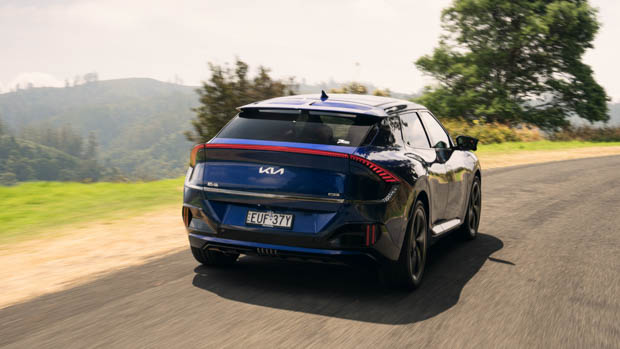
We’re thrilled when an EV goes around corners as well – or better – than it accelerates, because this is just so rare for this type of car. Heavy batteries far too often blight handling and seemingly ruin supple ride quality. Kia, like Porsche’s Taycan, has avoided this in the EV6.
Of course, many people do care about the EV6 GT’s blistering straight-line performance, even though this is a much less distinct feature in the EV world: even electric Volvos with sensible styling can now sprint from 0-100km/h in 4.52 sec (as tested).
The Kia is quicker than that, though. The manufacturer claims 3.6 sec, though we’re yet to test this metric at our own test track. That will come later.
This feat is made possible by using extensively reworked motors sourced from elsewhere within the Hyundai-Kia E-GMP platform development group.

The dominant motor is at the rear. The bones are the same as the AWD version of the EV6 GT-Line – except that rear motor power is turned up to 270kW by way of additional cooling, and a double inverter that allows maximum revolutions of 21,000 rpm.
Such high motor turning speed means the EV6 GT can reach a claimed top speed of 260km/h – which is considerably faster than most electric cars.
At the front, Kia actually uses the 160kW rear motor from the related Genesis GV60 model, but turns it sideways so that it fits properly.
Kia also claims that the EV6 GT’s uprated braking package shaves a considerable two metres from the car’s 100-0km/h stopping distance – another measurement we’ll be testing ourselves soon.
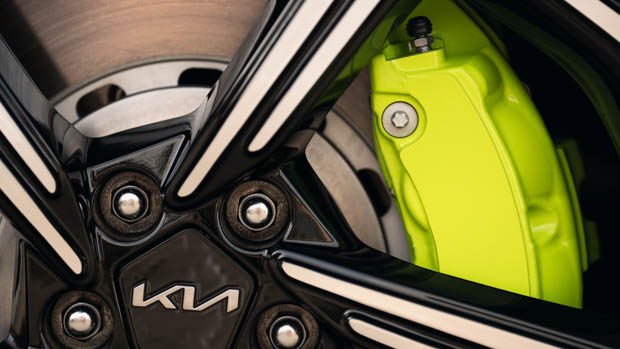
The stoppers are ventilated all round, with discs measuring 380mm at the front and 360mm at the rear, and their bite feels remarkably natural. A one-pedal driving mode coined i-Pedal is also available, but this must be manually selected by paddle shifter every time the vehicle is restarted.
Before setting off on our extensive preview drive through rural Victoria, we were warned that the road noise might surprise after the quietness of the GT-Line version.
This turned out not to be an issue – despite the Michelin rubber being on the aggressive side, the EV6 GT is still remarkably quiet, partially thanks to its acoustically-laminated front door glass.
Here is the EV6 GT’s weak spot: the interior isn’t up-to-scratch at the $100,000 mark. This is mainly due to the use of materials that you’d expect to find in a $40,000 SUV.
Now, for many buyers, the astonishing performance and very respectable Australian-tuned handling will trump this concern, but Kia’s mission will be to marry impressive driving dynamics with a more plush interior for the second-gen EV6.
Hardcore owners that actually intend to track their EV6 will appreciate the selection of a manually-adjustable bucket seat that can get as low as possible into the vehicle. Power seats normally can’t sink quite so low because of the room their motors require.

But given this car’s intended use as a GT – grand tourer – and specifically not as a track car, as creator Albert Biermann has told Chasing Cars, the decision to ditch the EV6 GT-Line’s excellent ‘relaxation’ comfort front seats, with their power adjustment and appreciated-in-Australia ventilation – is the wrong one.
If you are the sole driver then naturally, you can crank the seat into the correct position for you and leave it there forever. And for those with narrow frames, at least, the pews are incredibly supportive and comfortable. There’s no question that they really hold you in well while cornering (or using the GT’s drift mode).
You then grip the vegan-leather steering wheel and find that the artificial substitute isn’t quite right, with a slightly odd texture. The Polestar 2 Performance has the same issue – and it’s clear to us that non-leather alternative materials have a way to go before they will match the tactility of the real thing.

Like the exterior of the vehicle, there’s a neon-green accent theme to the interior of the EV6 GT, with the colour popping in the seat piping and on the steering wheel’s dedicated GT mode access button.
You’ll also find green highlights in the GT’s subtly tweaked screens on the EV6’s twin 12.3-inch displays – one for the driver, controlled via steering wheel buttons, and a central touchscreen display that metes out navigation, audio and smartphone mirroring.
But Kia continues to soldier on with the wired form of Apple CarPlay and Android Auto when nearly all rivals at this price have wireless connectivity. The Hyundai-Kia group still has not resolved its bitter and enduring dispute with a large smartphone manufacturer.

Standard fitment on the GT – like the GT-Line – is a 14-speaker Meridian premium stereo with a subwoofer. The attractive speaker grilles and extensive software customisation promise much, but the fidelity is very middling with a woolly acoustic. Perhaps we haven’t quite gotten our EQ settings right yet.
Storage is excellent in the EV6 and the GT is no exception. Kia has made full use of the model’s dedicated electric vehicle platform and has carved out massive amounts of room below the centre console where even a small backpack can be easily stored.
The sense of space carries through to the second row, which has palatial legroom thanks to the EV6’s 2900 mm wheelbase. Compared to some EVs, the back seats are reasonably supportive, though the high floor does require longer-legged passengers to splay their limbs a little to get comfortable. The entirely hard door skins are unacceptable at this price.

Like the front seats, the back seats are heated. This is mostly so that occupants can be warmed more efficiently in the winter. Blasting warm air through the climate control system consumes more electricity than using seat heaters.
Behind an electric tailgate sits the EV6’s 480 litre boot. It’s a big, square, largely featureless space – you’ll get a few suitcases back here without worry. However, the EV6’s cutaway, coupe-like roofline means it’s not as practical as the company’s Sorento SUV, for instance.
Plus, the EV6 is the only Kia that goes without a spare wheel – entirely. Not even a space-saver is available – all variants, including the GT, make do with a tyre repair kit. There is a tiny 20-litre frunk around the front.
The regular Kia EV6 has a five-star ANCAP safety rating. However, this specifically does not apply to the GT model.
Kia Australia told us that the reason the GT is excluded from the EV6’s five-star rating is because the decision to swap to the sportier front bucket seat shape changes side-impact body movements enough to invalidate the rating here.
It could be reasonable to assume that much of the crashworthiness and integrity of the regular EV6 would apply to this model because few changes have been made to the design.

Further, in our testing, we’ve found the tuning of Kia’s adaptive safety systems to be among the best in the industry, with a smooth and useful lane-centring aid that makes road trips less fatiguing.
Additionally, we love the blind spot view cameras that are used by Kia, Hyundai and Genesis.
Standard safety equipment on the EV6 GT includes:
Significant gulfs are starting to open up in the EV market between efficient and inefficient models. The regular Kia EV6 – even the 239kW GT-Line AWD version – is pretty economical on volts.
The same cannot be said for the GT. Somewhere in the process of substantially enhancing the capability of the shared rear motor, efficiencies have been sacrificed for alacritous performance.
To avoid excess additional weight, the EV6 GT shares the regular model’s 74.0kWh usable lithium-ion battery, but its energy consumption is much higher. As a result, the car’s WLTP range claim dips by almost 15 percent, from 484km to 424km.
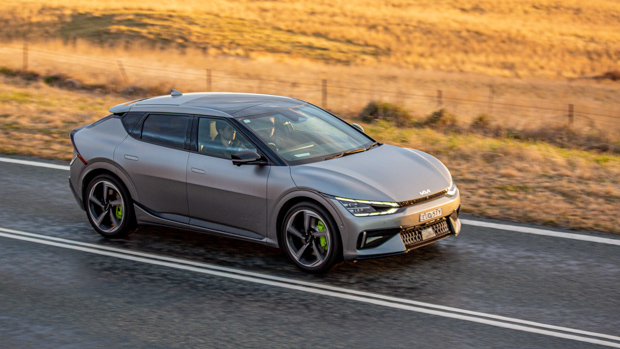
Our initial testing with the car took in highway transit legs and spirited back-road driving. In these environments, the GT used 19.0kWh/100km and 21.0kWh/100km respectively. That meant our touring range was between 352km and 389km.
So you’ll be grateful for the EV6 GT’s exceptional recharging capabilities. Find a 350kW charger – which is becoming easier in some parts of Australia – and the Kia can charge at peak speeds of around 240kW, rocketing it from 40–310km of range in under 20 minutes.
Later, we’ll perform our independent Chasing Cars range and charging tests on the car to see how it really fares for road trips.

A further gulf in the EV market has opened up in the area of servicing. Tesla uses condition-based servicing informed by an app. Porsche only wants to see Taycan owners once every two years – as does Polestar – but Kia is insisting on annual/15,000km visits.
You can purchase an up-front service plan for the EV6 GT which locks in today’s pricing. Five years of cover costs $1371, averaging $274 per year.
Kia is well-known in Australia for its seven year/unlimited kilometre new car warranty, and that cover does apply to the EV6 GT.
However, the battery and high-voltage components are covered by Kia’s global seven year/150,000km warranty, which is a bit shorter than the usual eight year warranty that tends to apply to most EV batteries.
The EV6 GT is an astonishing feat of engineering. That would be the case no matter which manufacturer built such a vehicle.
However, the fact that the model comes from Kia – a brand with no existing pedigree in this sort of performance space – is all the more impressive and is the clearest signal yet of the seriousness of Kia’s approach in the 2020s.
Others have already coined the EV6 GT a performance bargain, and we are inclined to agree.
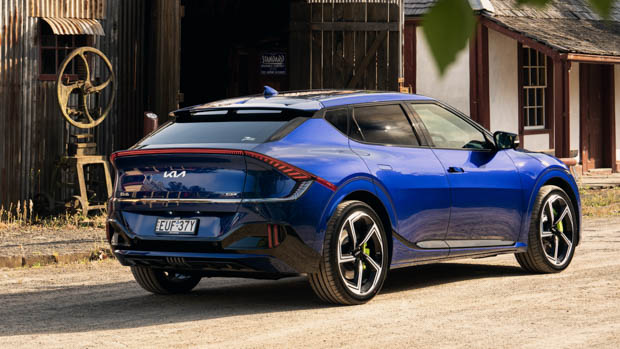
However, corners have been cut to get the car to its circa-$100K price point – including settling for an interior that is shaded by (admittedly slower) combustion-powered performance cars at this price, such as the BMW M340i ($104,900).
Still, we’re won over by the GT’s fantastic Australian suspension and steering tune – plus the killer app of its truly rapid 800-volt charging capabilities that in part make up for the decidedly average touring range.
The next question on our minds is about what Hyundai will do with very similar mechanicals: that car is coming soon in the form of the Ioniq 5 N.
About Chasing cars
Chasing Cars reviews are 100% independent.
Because we are powered by Budget Direct Insurance, we don’t receive advertising or sales revenue from car manufacturers.
We’re truly independent – giving you Australia’s best car reviews.
The estimate provided does not take into account your personal circumstances but is intended to give a general indication of the cost of insurance, in order to obtain a complete quote, please visit www.budgetdirect.com.au. Estimate includes 15%^ online discount.
^Conditions Apply
Budget Direct Insurance arranged by Auto & General Services Pty Ltd ACN 003 617 909(AGS) AFSL 241 411, for and on behalf of the insurer, Auto & General Insurance Company Limited(ABN 42 111 586 353, AFSL 285 571).Because we don’t know your financial needs, we can’t advise you if this insurance will suit you. You should consider your needs and the Product Disclosure Statement before making a decision to buy insurance. Terms and conditions apply.
Indicative quote based on assumptions including postcode , 40 year old male with no offences, licence suspensions or claims in the last 5 years, a NCD Rating 1 and no younger drivers listed. White car, driven up to 10,000kms a year, unfinanced, with no modifications, factory options and/or non-standard accessories, private use only and garaged at night.
^Online Discounts Terms & Conditions
1. Discounts apply to the premium paid for a new Budget Direct Gold Comprehensive Car Insurance, Third Party Property Only or Third Party Property, Fire & Theft Insurance policy initiated online on or after 29 March 2017. Discounts do not apply to optional Roadside Assistance.
2. Discounts do not apply to any renewal offer of insurance.
3. Discounts only apply to the insurance portion of the premium. Discounts are applied before government charges, taxes, levies and fees, including instalment processing fees (as applicable). The full extent of discounts may therefore be impacted.
4. We reserve the right to change the offer without notice.